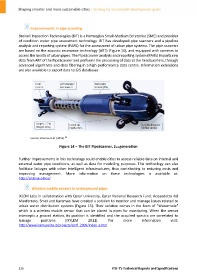Page 536 - Shaping smarter and more sustainable cities - Striving for sustainable development goals
P. 536
Improvements in pipe scanning
Breivoll Inspection Technologies (BIT) is a Norwegian Small‐Medium Enterprise (SME) and provider
of condition water pipe assessment technology. BIT has developed pipe scanners and a pipeline
analysis and reporting system (PARS) for the assessment of urban pipe systems. The pipe scanners
are based on the acoustic resonance technology (ART) (Figure 14), and equipped with cameras to
access the health of urban pipes. The PipeScanner analysis and reporting system (PARS) imports raw
data from ART of the PipeScanner and performs the processing of data at the headquarters, through
advanced algorithms and data filtering in a high‐performance data centre. Information extensions
are also available to export data to GIS databases.
35
Source: Brenna et al. (2013).
Figure 14 – The BIT PipeScanner, 2nd generation
Further improvements in this technology could enable cities to access reliable data on internal and
external water pipe conditions, as well as data for modelling purposes. This technology can also
facilitate linkages with other intelligent infrastructures, thus contributing to reducing costs and
improving management. More information on these technologies is available at:
http://en.breivoll.no/
Wireless mobile sensors in underground pipes
iXLEM Labs in collaboration with Qatar University, Qatar National Research Fund, Acquedotto del
Monferrato, Smat and Karamaa have created a solution to monitor and manage issues related to
urban water distribution systems (Figure 15). Their solution comes in the form of "Watermole"
which is a wireless mobile sensor that can be placed in pipes for monitoring. When the sensor
intercepts a ground station, its position is identified and the acquired spectra are correlated to
leakage positions (iXYLEM 2011). For more information visit:
http://www.ixem.polito.it/projects/qnrf_2009/index_e.htm
526 ITU‐T's Technical Reports and Specifications

